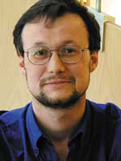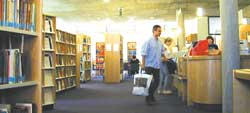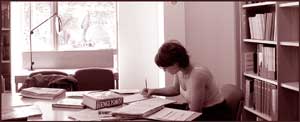PLEASE VISIT OUR NEW WEBSITE
"Libraries are about information and computers are the way to transmit that information"
The Central School of Speech and Drama is situated at the Embassy Theatre in London. A publicly funded Higher Education institution, Central specialises in the performing arts. The three main areas of the school are performance; production, art & design; and education.
The Central has approximately 720 students and 86 members of staff of which 40 are academics and 46 are support staff. In 1997 a strategic decision was made to converge the library with the media and computing services departments.


 Notable former students of the school include the late Sir Laurence Olivier, Dame Judi Dench, Dawn French, Jennifer Saunders, Steven Tompkinson, Christopher Eccleston, Joss Ackland and James Fox.
Notable former students of the school include the late Sir Laurence Olivier, Dame Judi Dench, Dawn French, Jennifer Saunders, Steven Tompkinson, Christopher Eccleston, Joss Ackland and James Fox.
Central is, by nature, a centre of practical learning and is therefore not a heavily research-based institution. This means that although the library collection is smaller than that of many other HE institutions, its contents are specialised and widely used. The library holds traditional materials such as books and journals, but also provides other media types, particularly audio and video recordings which are vital for training in techniques and delivery of creative expression. The materials are practical and rich and nothing exists in the library that is not of measurable use to the students. The library plays a vital role within the College.
 Adam Edwards' first task as the new Head of Learning and Information Services was to update and improve the library provision when they moved into a new building in September 1997. As well as overseeing the convergence of the library with the media and computing services departments, Adam began to address the question of the ailing library management system which he had inherited. If it is true that from the philosophy comes the policy, then in Adam Edwards' case that meant turning the library into more than just a repository for books, it had to become a service centre for information, with emphasis on the word service.
Adam Edwards' first task as the new Head of Learning and Information Services was to update and improve the library provision when they moved into a new building in September 1997. As well as overseeing the convergence of the library with the media and computing services departments, Adam began to address the question of the ailing library management system which he had inherited. If it is true that from the philosophy comes the policy, then in Adam Edwards' case that meant turning the library into more than just a repository for books, it had to become a service centre for information, with emphasis on the word service.
"In the past, learning resources had been rather passive. Nowadays the customer care side is critical: the crucial thing is service."
 Adam was sure that the library had not fulfilled its potential. Items were difficult to find without help from library staff and, whilst it is necessary to have staff available to help, it ought not to be necessary for every visitor. The organisation and presentation of materials required a rethink and the library staff deserved better and more modern tools to provide a good and efficient service.
Adam was sure that the library had not fulfilled its potential. Items were difficult to find without help from library staff and, whilst it is necessary to have staff available to help, it ought not to be necessary for every visitor. The organisation and presentation of materials required a rethink and the library staff deserved better and more modern tools to provide a good and efficient service.
The existing system, an old version of CAIRS, was unsatisfactory in a number of ways and particularly in the way it offered information to staff and customers, so Adam set out to find a system that would provide the service that he felt his students and staff deserved.
OPAC
As service was at the centre of Adam's thinking, he had to put the student interface at the top of his criteria for a new system. He wanted to help his students get the most out of the resources available and that meant that any system he adopted should guide them through the library in much the same way as the library staff might.
 One of the systems Adam investigated was Heritage from IS Oxford. The OPAC (Online Public Access Catalogue) appealed to him immediately because it allowed the user to search any or all fields in a catalogued record. This feature was vital for casual enquirers because they are not party to the cataloguing conventions of the library, and would therefore have no idea which field a word appears in, other than, perhaps, the author's name or a part of the title.
One of the systems Adam investigated was Heritage from IS Oxford. The OPAC (Online Public Access Catalogue) appealed to him immediately because it allowed the user to search any or all fields in a catalogued record. This feature was vital for casual enquirers because they are not party to the cataloguing conventions of the library, and would therefore have no idea which field a word appears in, other than, perhaps, the author's name or a part of the title.
"We're not commercial, but students are paying fees... and it's not cheap, so we should get it right."
Adam was also impressed with the way in which the OPAC could get users to enter their areas of special interest and then inform them of any additions to the catalogue which matched. Users could also view a floor plan map of the library to see where items are located.
Learning difficulties
Adam was aware that the way the system looked was as important as the way it functioned. Good aesthetics are a significant aid to learning, because obstacles are smoothed out with elegant design, for example, the incentive to learn is greater if the interface is attractive. Adam thought that the Heritage OPAC offered a fine combination of form and function: "...there's a balance between giving people enough choices, but also not confusing them".
 Central has a relatively high number of dyslexic students because the emphasis is on practical, performance-related expression, as opposed to a more academic approach. Adam researched different systems, and had demonstrations from several different companies. Dyslexic students were invited to all demonstrations to `road-test' the systems, to see how they coped with human error.
Central has a relatively high number of dyslexic students because the emphasis is on practical, performance-related expression, as opposed to a more academic approach. Adam researched different systems, and had demonstrations from several different companies. Dyslexic students were invited to all demonstrations to `road-test' the systems, to see how they coped with human error.
"The key thing for them was when you type a word into the interface, what happens if you misspell it? Some systems just gave no results or spurious ones"
Heritage performed well on this score: it had the ability to show misspellings as users typed them, rather than after they had pressed the enter button and failed with the search. It also allowed them to truncate words with a `wild card' symbol, so that it was not necessary to type in the whole word if unsure of the spelling.
"..that's where Heritage won. It was an easy, straightforward, simple-to-use interface; and that was terribly, terribly important."
Some of the new technologies in Heritage are particularly important to Central given its performance-related role. Adam recognises that the impact of modern media can be greater than many words: "A website 'journal' that shows clips of performance or has a bit of sound recording to say 'this is what this person sounds like' can be far more valuable than the printed page."
Web access to and from the catalogue
These days the library provision doesn't begin and end at the four walls. The Internet has had a great impact and offers one big global library. The difficulty lies in finding what you are looking for. Adam was keen to provide links to relevant websites, and if possible provide a means of going straight to them. Heritage provides ways of linking websites and other media to the catalogue so that users are able to find and visit sites as part of a normal catalogue search. The role of the librarian in this context is much the same as it has always been; using research skills, finding information and putting it and people together.
"They may not know what is available on the Internet and rather than waste time searching... we can actually say `here's some good things to use'."
Increasingly, Central is forging new links with other agencies and has distance learning students in other parts of the country; they all need to access the catalogue. Heritage has a module which publishes the catalogue to the web so that interested parties can search it and contact the library with specific requests. This has resulted in the library enjoying greater prominence and the resources being better used.
Productivity and economics
The old CAIRS system was slow and hard to use. Issues were still manual. This had become a bottleneck both in terms of information provision and administration.
"...we were spending perhaps a couple of thousand pounds a year in terms of staff time simply filing bits of paper, which went as soon as we got Heritage."
The change to Heritage liberated library staff from much of the administration of running a library, so that they could be available to help users with their research. A better service soon became a reality.
"With a computer you can zap the bar-code, keep one eye on the screen and you can actually communicate with the user. It enables you to focus on the customer, and that's the great advantage of good IT."
Since installation, Central has catalogued media equipment – such as camcorders and tape players – in Heritage to control their use. For the Media Services Manager, this has meant an end to paper records for issues and is very useful in resolving disputes when equipment is returned late.
Support
One other vital consideration in implementing new systems is technical backup. Adam found the Heritage support team "competent, helpful, and pleasant to deal with". He commented on the positive `grass-roots' attitude of the managers, who were unafraid to "get stuck in and get their fingers dirty". If a support engineer was unable to answer a query, they ensured that someone else could help. IS Oxford is a UK company (one of the few in library system development) which means that if a problem is difficult to resolve, the developers of the software are to hand. It also means that the user group is a meaningful forum, because users can actually meet the developers. Other systems suppliers tend to maintain a sales and training presence here in the UK, with the development team based elsewhere.
The future
There are additional Heritage modules which Central will implement in the coming years. The next priority is to implement serials control and downloading of catalogue records, to save staff time. Long term they would like to see advanced bookings to eliminate paper booking of both media equipment and computers in the student computer rooms.
Central originally purchasd Heritage with five additional full access user licences, three OPAC only user licences, Heritage Online, the Serials Management Module, the Reader Import Module and the Server Performance pack. Their data was converted from CAIRS by IS staff. They have since added Heritage Connect Live, Fines and Quickcat Online
A more detailed article by Adam Edwards on the selection of Heritage can be found in Vine, the journal of the Library Information Technology Centre at South Bank University:
Edwards, Adam, Heritage; new system installation at Central School of Speech and Drama, Vine, 115, December 1999, 24 - 33



